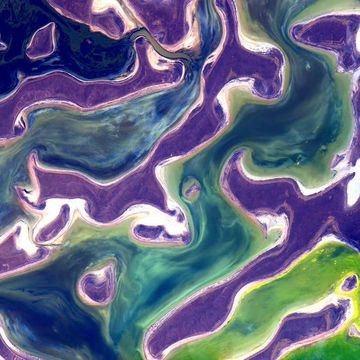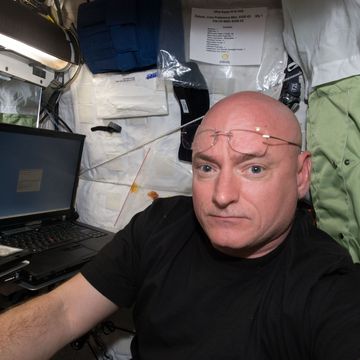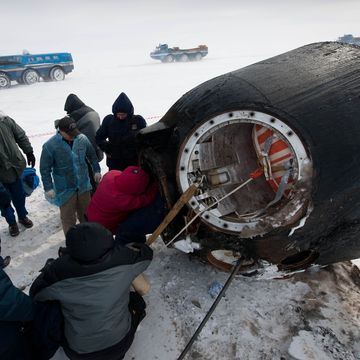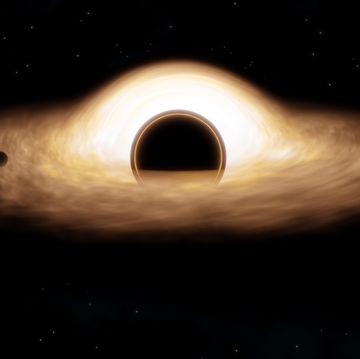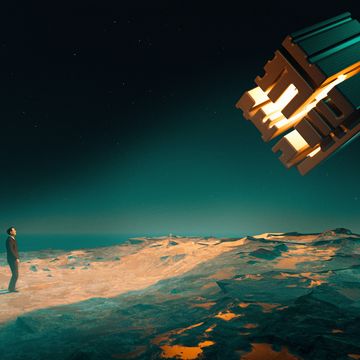Scott Kelly, a decorated astronaut who's been with the agency since 1996, is heading to the International Space Station for a year-long stay. During that time, he'll become the American with the longest duration in space, and will provide NASA with useful information on the long-term effects of microgravity on humans as the agency looks forward to new deep space missions in the coming decades.
Kelly's flight will be an important one for the agency. But here are some things about it you might want to know as Kelly makes his way up there.
1) The Experiment Has a Perfect Control Group: Kelly's Twin Brother
With Kelly going to space for a full year, NASA needs to know how his body has changed over that time. They have a perfect ground based control group: Kelly's brother Mark is also a decorated astronaut, having flown four shuttle missions and logged 38 days in space.
While NASA monitors Scott's health in space, they'll be able to test Mark to see what kind of physiological changes take place in microgravity. As the first siblings to both see time in space as NASA astronauts, it's a unique opportunity for the agency.
Also, for Expedition 45, Scott Kelly and crewmates dressed like Jedi Knights. Mark Kelly and his crew on the STS-143 mission mocked themselves up like a Star Trek movie poster. Both brothers are total dorks, on opposite sides of the franchise war.
2) This Will Be the Longest Time in Space (for an American)
Russia has sent three cosmonauts up for missions lasting longer than a year – including Valeri Polyakov's record 437 days in space aboard the space station Mir. But Kelly's flight will be the longest stay by an astronaut, or any International Space Station resident for that matter. Previously, Russian Mikhail Tyurin and Spanish-American Michael López-Alegría spent a 215 days together on the ISS, making them the current record-holders.
Only four people have ever had a space residency that lasted a year or longer. Besides Polyakov there is Sergei Avdeyev, who spent 379 days on Mir before returning in 1999. Vladimir Titov and Musa Manarov spent exactly one year on Mir from December 1987 to December 1988. Kelly's stay will fall just short of one whole year, at 342 days.
3) He Won't Be Alone Up There
Joining Kelly in his stay is Mikhail Kornienko, a Russian cosmonaut. Both Kelly and Korienko have already spent time aboard the ISS, albeit at separate times. Kelly has logged a total of 180 days in space; Korienko a total of 176.
Korienko last came down about two weeks before Kelly went up, with Korienko returning to Earth on September 25, 2010, and Kelly arriving on October 9, 2010.
4) Kelly's Last Stay Was Cut Short
While he was serving as commander of Expedition 26 in 2010 and 2011, Kelly's sister-in-law, former Rep. Gabrielle Giffords, was shot in a would-be assassination. So Kelly came back to Earth two months before his planned departure from the station. He landed in Kazakhstan on March 11, 2011, then flew to Houston to be with Mark and Gabrielle. Giffords was shot on January 8, 2011. She was in a rehabilitation center in Houston when Scott arrived.
5) The Numbers Add Up
Kelly will spend 342 days in space on this mission. He spent 159 days aboard on his last stay, plus an eight-day shuttle mission to service the Hubble Space Telescope and a 12-day docking at the station aboard the Space Shuttle Endeavor, where he commanded the team that installed a new truss segment, gyroscopes, and electrical systems to the space station in 2007. (On the latter mission, his wake-up call song was "Mr. Blue Sky" by Electric Light Orchestra.)
At the end of this, Kelly will have a total of 522 days in space (adding on a day for accumlated hours spent), which will beat out Mike Fincke's total record of 382 days in space. Because he's been on a Hubble servicing mission, Kelly has also flown higher than a majority of astronauts since the Apollo era ended. Hubble is 347 miles above the Earth, while the ISS is 249 miles.



